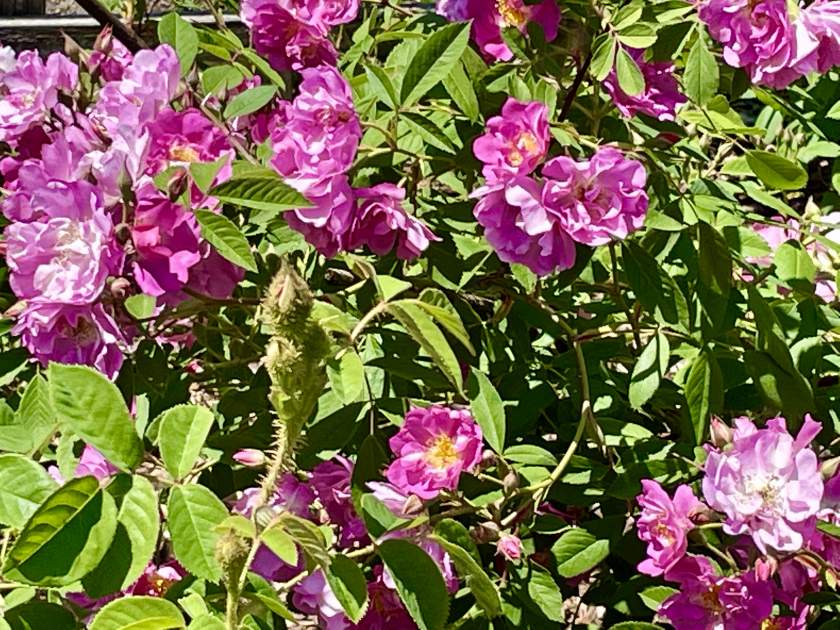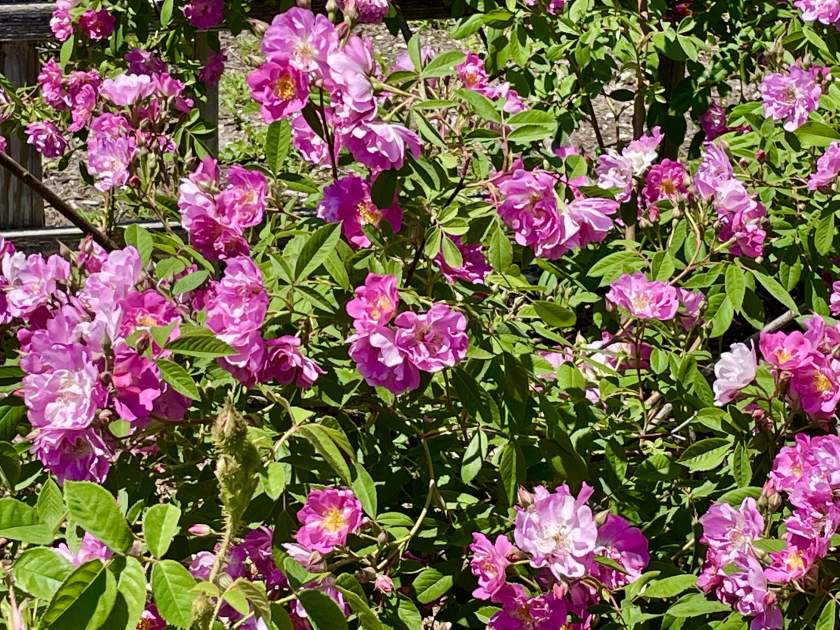Rosa ‘James Mitchell’ Moss: A Fragrant Delight in the Rosaceae Family
Rosa ‘James Mitchell’ Moss or Moss Rose ‘James Mitchell’ is a captivating addition to the Rosaceae family. This hybridized variety, introduced in 1861 by Verdier, has stood the test of time with its remarkable beauty and desirable traits. Known for its medium pink double flowers and delightful fragrance, this moss rose cultivar is a cherished gem in gardens around the world.
Family and Hybridization
Belonging to the Rosaceae family, Rosa ‘James Mitchell’ shares its lineage with other beloved flowering plants. This family encompasses a wide range of species, including roses, strawberries, and various ornamental shrubs. The hybridization of ‘James Mitchell’ was masterfully carried out by Verdier, a renowned breeder. Louis-Eugène-Jules Verdier (1827- March 11, 1902, Paris) was the eldest son of Victor Verdier. He established his own enterprise where he specialized in cultivating a variety of flowers, including roses, peonies, gladiolus, and others.
Registered and Class Information
Moss Rose ‘James Mitchell’ made its debut in the gardening world in 1861. This date marks its registration or introduction, signifying its recognition and availability to enthusiasts. Classified as a moss rose, this variety belongs to a distinctive group known for its unique moss-like growth on the flower buds and stems.
Moss roses have a fascinating history, originating as sports or mutations of Centifolia and Damask roses in the eighteenth century. These unique varieties inherited the repeat blooming traits and darker colors of their parent roses. What sets the Moss roses apart is their distinctive feature—the fragrant, piney-scented glands that adorn the buds, sepals, and pedicels, lending them a velvety and fuzzy appearance. This attribute is exclusive to the Moss class and adds to their allure.
Moss roses exhibit varying sizes and garden habits, and while they are generally hardy, they are susceptible to powdery mildew under favorable conditions. In early summer, they burst into abundant blooms, ranging in color from pristine white to deep crimson, with some varieties even offering a second flush of flowers later in the season.
Plant Characteristics of Rosa ‘James Mitchell’:
Moss Rose ‘James Mitchell’ boasts a height ranging from 4 to 6 feet (1.2-1.8 meters), making it a substantial presence in the garden landscape. When planting multiple specimens, space them approximately 36 to 48 inches (90-120 centimeters) apart to allow for proper growth and air circulation.
Blooms and Fragrance
The enchanting flowers of Moss Rose ‘James Mitchell’ are a medium pink hue, radiating a sense of grace and elegance. What sets this variety apart is its double bloom shape, with multiple layers of petals creating a lush and full appearance. As you approach the blooms, a captivating fragrance fills the air, captivating both sight and scent.
Bloom Time and Habit
Moss Rose ‘James Mitchell’ graces the garden with its abundant blooms in late spring to early summer. During this time, the plant becomes a spectacle of color and fragrance, attracting pollinators and providing a visual feast for onlookers. With its bushy habit, this variety presents a compact and well-rounded form, adding structure and charm to any garden space.
Exceptional Traits and Details
Moss Rose ‘James Mitchell’ possesses several exceptional traits and details that enhance its desirability:
- Resistance to Black Spot: This variety shows resilience to black spot, a common fungal disease that affects roses. Its natural resistance allows for healthier foliage and prolonged beauty.
- Resistance to Mildew: Moss Rose ‘James Mitchell’ also demonstrates resistance to mildew, another fungal disease that can affect roses. This attribute ensures the plant’s overall vigor and reduces the need for intervention.
- Non-Patented: Unlike some other rose cultivars, Moss Rose ‘James Mitchell’ is non-patented, allowing for wider availability and potential propagation.

Cultivation of Rosa ‘James Mitchell’:
Sunlight: Rosa ‘James Mitchell’ thrives in full sun. It requires at least six hours of direct sunlight each day to ensure optimal growth and abundant flowering. Place the plant in a location where it can receive ample sunlight throughout the day.
Watering: Regular and deep watering is essential for the health and vitality of Rosa ‘James Mitchell’. Water the plant deeply, ensuring that the water reaches the root zone. During dry spells or hot weather, increase the frequency of watering to prevent drought stress. However, be cautious not to overwater, as excessive moisture can lead to root rot. Maintain consistent soil moisture levels without waterlogging.
Soil: Rosa ‘James Mitchell’ prefers moderately acidic soil with a pH range of 5.6-6.0. However, it can also tolerate slightly acidic (6.1-6.5), neutral (6.6-7.3), and slightly alkaline (7.4-7.8) soils. Ensure that the soil is well-draining and enriched with organic matter. Prior to planting, consider amending the soil with compost or well-rotted manure to improve its fertility and drainage.
Pests and Diseases: Rosa ‘James Mitchell’ is susceptible to common rose pests such as aphids, spider mites, and thrips. Regular inspection of the plant is crucial to detect any pest infestations early on. Treat affected plants with appropriate insecticidal soaps or insecticides to control the pests. Additionally, monitor the plant for signs of diseases such as black spots or powdery mildew. If disease symptoms are observed, apply suitable fungicides to prevent the spread and manage the disease.
Propagation:
Rosa ‘James Mitchell’ can be propagated through stem cuttings. Take stem cuttings from a healthy and established plant, ensuring each cutting has several nodes. Remove the lower leaves, dip the cut end in the rooting hormone, and plant the cutting in a well-draining potting mix. Place the cutting in a warm and humid environment, and provide consistent moisture until roots develop. Once rooted, transplant the cutting into a suitable growing medium or desired location in the garden.
Pruning Instructions
To maintain the health and flowering capacity of Moss Rose ‘James Mitchell,’ follow these pruning instructions:
- Blooms on Old Wood: This variety produces flowers on the previous year’s growth. As a result, it is best to prune after the flowering period to avoid removing potential blossoms.
- Prune selectively, removing any dead, damaged, or diseased wood. This practice promotes airflow, reduces the risk of pests and diseases, and encourages healthy new growth.
Embrace the Fragrant Beauty of Moss Rose ‘James Mitchell’
With its mesmerizing pink blooms, delightful fragrance, and exceptional characteristics, Moss Rose ‘James Mitchell’ is a testament to the allure of roses. Whether planted as a standalone specimen or as part of a larger rose collection, this variety is sure to captivate both the eyes and the senses. Celebrate the beauty of Moss Rose ‘James Mitchell’ in your garden and let its fragrant blooms transport you to a realm of floral enchantment.




